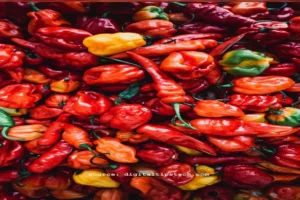A Guide to Harvesting Perfectly Ripe Poblanos
When to Pick Poblano Peppers? Poblano peppers are a versatile and flavorful ingredient in many dishes, from Mexican cuisine to various international recipes. Knowing when to pick poblano peppers is crucial to ensure you harvest them at their peak flavor and texture. In this guide, we’ll delve into the art of picking poblano peppers, taking you through the different stages of ripeness, the signs to look for, and the best practices for harvesting them. Whether you’re a seasoned gardener or a beginner, this article will provide you with the knowledge you need to enjoy the best-tasting poblanos.

Poblano peppers are usually harvested once they have reached their full size and acquired their distinct dark green hue. The exact timing of when to pick them depends on your intended use and personal preference.
Understanding Poblano Pepper Ripening
Poblano peppers undergo various stages of ripening as they grow on the plant. They start off green and gradually change in color, flavor, and heat level as they mature. Properly timing the harvest ensures you get the desired taste and heat characteristics.
Signs of Ripeness
Ripe poblanos display a vibrant deep green or even a slightly reddish hue, depending on the variety. They should feel firm and taut to the touch, indicating that they are fully developed and plump. Wrinkles, spots, or a dull appearance are signs that the pepper might be overripe or past its prime.
The Importance of Proper Timing
Timing is crucial when it comes to picking poblano peppers. Harvesting too early can result in underdeveloped peppers with a bitter taste, while waiting too long might lead to overly spicy and tough peppers. Finding the right balance is key to enjoying the rich, earthy flavor poblanos are known for.
Step-by-Step Guide to Picking Poblano Peppers
Step 1: Perfect timing for Poblano
Harvest your poblano peppers during the cooler parts of the day, such as early morning or late afternoon. This helps prevent stress on the plants and ensures your peppers stay fresh.
Step 2: Inspect the Pepper’s Color
Look for peppers that have reached the desired color for their variety. Remember that red poblanos are riper and sweeter than green ones. Avoid picking peppers that are still predominantly green.
Step 3: Examine the Texture
Gently touch the pepper to feel its texture. A ripe poblano will be firm but not too hard. If it feels soft or shriveled, it’s likely past its prime.
Step 4: Use Pruning Shears or Scissors
To avoid damaging the plant, use clean pruning shears or scissors to snip the pepper’s stem about an inch above the fruit.
Step 5: Handle with Care
Handle the peppers carefully to prevent bruising. Place them in a container or basket lined with a soft material to avoid damage during transportation.
Post-Harvest Handling of Poblanos
After picking, it’s essential to store poblanos properly. Place them in a cool, dry place or store them in the refrigerator to prolong their freshness.
Ways to Utilize Freshly Picked Poblanos
Fresh poblanos can be used in a variety of dishes, from stuffed peppers and salsas to soups and stir-fries. Their mild heat and distinct flavor enhance the taste of your culinary creations.
Storing and Preserving Poblanos
If you have more poblanos than you can use immediately, consider freezing or roasting them for later use. Freezing preserves their flavor, while roasting adds a smoky depth to their taste.
General guidelines:
Size:
Poblano peppers are usually around 4 to 6 inches long and 2 to 3 inches wide when mature. You can start harvesting them when they have reached this size.

Color:
The standard harvesting time for poblanos is when they are dark green. However, if you prefer a sweeter and slightly less spicy flavor, you can wait until they turn reddish-brown. The red poblanos are known as “ancho” peppers and have a milder taste.
Firmness:
Delicately press the pepper to assess its solidity. A ripe poblano pepper should be firm but not overly hard.
Harvesting Time:
Poblano peppers typically take around 60 to 80 days to mature after transplanting. It also depend on the variety, cultivation region and growing conditions.
Weather:
If there’s a risk of frost or cold temperatures in your area, it’s best to harvest the peppers before the temperatures drop to avoid damage.
Regular Harvesting:
To encourage continued pepper production, it’s essential to harvest ripe peppers regularly. This helps the plant focus on producing more fruits.
FAQs:
1.Can I eat green poblanos, or should I wait for them to turn red?
Green poblanos are edible and have a unique flavor, but red poblanos are sweeter and fruitier. It’s a matter of personal preference.
2.How do I prevent my poblanos from turning too spicy?
Harvesting them at the right time and providing consistent watering can help control their spiciness.
3.What’s the best way to incorporate poblanos into my dishes?
Poblanos can be used in both cooked and raw dishes. They add a mild, smoky flavor that complements various cuisines.
4.Can I grow poblano peppers in containers?
Yes, you can grow them in containers as long as they receive adequate sunlight and care.
5.Are there any alternative uses for poblanos besides cooking?
Poblanos can be dried and ground into chili powder or used to infuse flavor into vinegar or oils.
Final Thoughts:
Knowing when to pick poblano peppers is an essential skill for any gardener or cooking enthusiast. By understanding the signs of ripeness, proper harvesting techniques, and the various uses of ripe poblanos, you can elevate your culinary creations and enjoy the rich flavors these peppers offer. So, grab your pruning shears and head to your garden when the time is right – your dishes will thank you!
Remember that personal taste preferences may vary, so you can experiment with harvesting at different stages to find the flavor and spiciness level that suits you best. Enjoy your homegrown when to Pick Poblano Peppers in various delicious dishes!